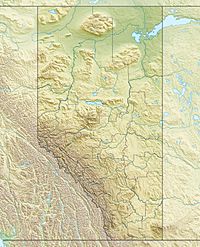Mount Charles Stewart facts for kids
Quick facts for kids Mount Charles Stewart |
|
|---|---|

Mount Charles Stewart (left) seen with Mount Lady McDonald (right)
|
|
| Highest point | |
| Elevation | 2,809 m (9,216 ft) |
| Prominence | 363 m (1,191 ft) |
| Listing | Mountains of Alberta |
| Geography | |
| Location | Alberta, Canada |
| Parent range | Fairholme Range Canadian Rockies |
| Topo map | NTS 82O/03 |
| Climbing | |
| First ascent | 1947 |
| Easiest route | rock climb |
Mount Charles Stewart is a tall mountain found in the Bow River valley. It is located within Banff National Park in Canada. This park is famous for its stunning mountain views.
The mountain was given its name in 1928. It was named after Charles Stewart. He was an important leader called the Premier of Alberta. A Premier is like a governor or a head of government for a province. Charles Stewart was Premier from 1917 to 1921.
Contents
How Mount Charles Stewart Was Formed
Understanding the Rocks of Mount Charles Stewart
Mount Charles Stewart is made up of sedimentary rock. This type of rock forms from layers of sand, mud, and tiny bits of plants and animals that settle over time. These layers get pressed together and harden into rock.
A Look Back in Time: Ancient Seas
The rocks in Mount Charles Stewart were formed a very long time ago. This happened during periods known as the Precambrian and Jurassic times. Imagine, these rocks were once soft sediments at the bottom of shallow seas!
The Power of Earth: Mountain Building
Later, a huge event called the Laramide orogeny took place. This was a time when the Earth's crust moved a lot. During this movement, the sedimentary rock layers were pushed up. They were even pushed over younger rocks, creating the big mountain we see today.
Climate Around Mount Charles Stewart
Weather in the Mountains
Mount Charles Stewart has a subarctic climate. This means it has very cold and snowy winters. The summers, however, are usually mild.
Winter Temperatures
In winter, temperatures can drop really low. It can be colder than −20 degrees Celsius. With the wind, it can feel even colder, sometimes below −30 degrees Celsius!
Water Flowing from the Mountain
When snow melts or rain falls on Mount Charles Stewart, the water flows down. This water eventually drains into the Bow River. The Bow River is a large river that then flows into the Saskatchewan River.


